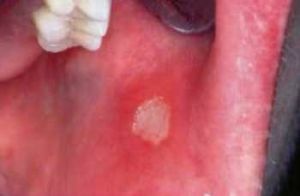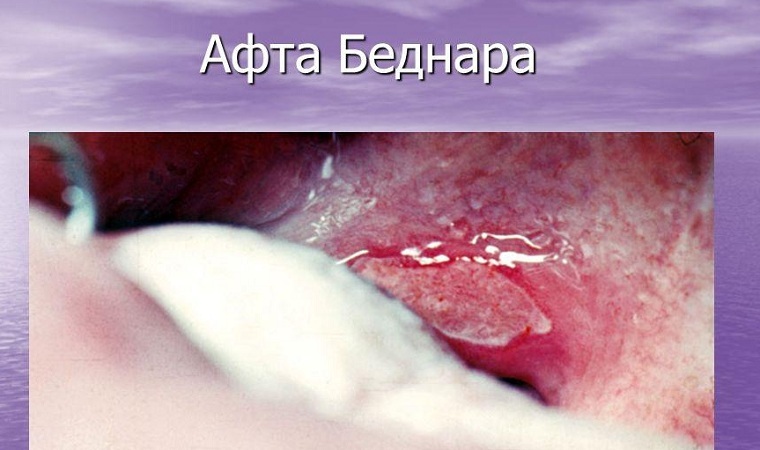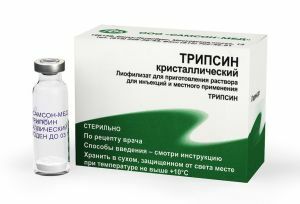 Why are Bednar's aphthas called that way - by the name of their first researcher? Are they special?
Why are Bednar's aphthas called that way - by the name of their first researcher? Are they special?
Yes, they, which are quite common in dentistry, are very different from other symptoms and disorders. And the differences from other types of ulcers of the oral mucosa are absolute.
Firstly, it is a disease exclusively of the childhood period of life, and secondly, the localization and appearance of ulcers are typical features for the Bednar aphthae. Finally, the disease has the features and current, characteristic for them.
And it all starts with a thumb. More precisely, with his sucking. It has long been noted that in children sucking a finger, Bednar's aphthae occur more often. The favorite object of the process is the thumb.
The Bednar aphthas are just in the area where this finger rests, supported by the tongue from below. This is the area of the palate, more precisely - the boundary of the hard palate with soft palate.
The mucous membrane in this zone is not very thick, and it is squeezed between the palatine bone, on the one hand, and the foreign object of sufficient hardness in the mouth, on the other, it is damaged. And at once for all depth( thickness).

The mechanism of injury in the formation of Bednar ulcers is comparable to that in the formation of decubitus. Therefore, as with it, the depth of tissue necrosis is significant.
So the "sweet finger", communication with which the child does not want to be interrupted either by day or night, causes a serious illness.
Other ASEFs
Other etiological factors
Adequate substitution for the "beloved finger" can be a different, sufficient density of foreign object for the oral cavity:
- inadequate properties(size, shape) or simply often given a dummy;
- items for oral care( for wiping it or others);
- any random objects, tightened in the child's mouth, not adapted specifically for sucking.
Among the initiating lesions of the factor epithelium, the nipple of the maternal breast with a high degree of coarsening is indicated.
For reasons that weaken the strength of the oral mucosa in a baby and facilitate its trauma, include:
- borne trauma;
- prematurity, hypotrophy;
- congenital malformations of the heart;
- presence in the oral cavity of pathogenic microorganisms and fungal spores or existing diseases of the said area;
- low level of innate immunity.

In children of the older( non-infectious) age, the onset of Bednar's apopaia is explained by the same etiological factors. But with the addition of several more in the form of unwillingness:
- properly care for the oral cavity;
- eat properly( with a lot of sweet in the diet).
Which, in turn, leads to:
- hormonal failures;
- vitamin deficiency;
- dysbiosis;
- low degree of immunity.
Sucking finger in older children( preschoolers and younger schoolchildren) is replaced by long-term presence in the mouth of foreign objects( pencils, pens and the like).
Symptomatics, course and diagnosis of
Bednar's Afts differ significantly from any, including aphthous and erosive forms of stomatitis.
A particularly deep-seated process is capable of leading to a perforation of the palate in combination with a secondary infection. But even in less severe cases, it takes several weeks to several months to heal Bernard's ulcers.
The picture of the lesion of the mucosa depends on the traumatic palate of the cause.
In chronic trauma, coarse nipple during breastfeeding erosion is located on the middle line of the palate. In the case of damage to the epithelium by sucking a finger, a contour of the butterfly forms as a care object or something stranger with the formation of a vast area of damage.
The location of erosion on the border of the soft palate with the harder is more often symmetrical, less often one-sided. Damage to the mucosa is rarely a single, several millimeters in size, more often it merges into extensive foci of lesions of mucous aft-erosion rounded, oval or elongated. 
The focus of the aphtha is clearly delineated from the not abruptly hyperemic and swollen surrounding tissues, their surface is covered with a virtually unselected loose fibrin deposit of gray-dirty-yellow color.
In the case where the surface of the aphthae is free of fibrin, it differs in color with a brighter color than surrounding surrounding tissues, which indicates the state of hyperaery.
With an especially deep lesion of the mucosa, the erosive stage is replaced by a ulcerative one, the activation of its own microbial and fungal flora promotes the spread of the process in breadth and depth.
The further development of the disease depends on:
- the vastness and depth of mucosal lesions;
- activity of microbial-fungal flora in the oral cavity;
- state of immunity and other factors.
In severe cases, there is an increase in temperature and the effects of intoxication, as in an infectious disease.
The diagnosis is based on the typical complaints of the mother, the history of the condition and the characteristic pattern of mucosal lesions.
Differentiate the state from:
- of nonspecific aphthous stomatitis;
- herpetic sore throat;
- ulcers of tuberculosis and syphilitic etiology.

The photo shows a thermal burn that is very different from Bednar's aphtha
. When the mucosa is thermally affected( from feeding with hot milk or broth), the nature of the lesion will be different: with the lesion of the lip area, the tip of the tongue, the anterior section of the hard palate, which become sharply edematous and hyperemic, become sharply painful when touched.
With a deeper burn from the epithelium, rapidly bursting bubbles form leaving white scraps with hyperemia in the base.
On the principles of treatment of
The precautionary measure should be the elimination of the causes leading to the occurrence of aft:
- normalization of the feeding process;
- weaning from bad habits;
- control of the implementation of hygiene standards;
- removal( if necessary) of baby teeth with premature eruption.
The first point for artificial feeding is the selection of nipples of adequate properties( short, of hard rubber, not stretched when sucked to reach the zone of erosion).Or it is the use of special pads when coarsening the skin of the nipples( when fed naturally).
The actual treatment includes the local treatment of the damaged zones of the oral mucosa in combination with the application of strengthening the body's health and immunity means.
The main difference from the treatment of aphthous stomatitis is a sequential( conducted in several stages in a certain order) daily application of a whole complex of medicines.
The algorithm for daily actions for the use of topical agents includes the following steps:
- Irrigation of affected areas with mucosal solutions of lysozyme and trypsin.

- Compression of a decoction of medicinal herbs: sage, chamomile, calendula, St. John's wort for infants, for older children - rinses of the same composition. Applicable weak official solutions of antiseptics( 3% Hydrogen peroxide or 0.25% Chloramine).
- Application of wound healing agent: Solcoseryl, sea buckthorn oil.
- Lubrication with anesthetic composition( anesthetic ointment, Kamistad gel).
The algorithm is repeated with strict implementation of the sequence of actions in the continuation of several days with mandatory regular medical supervision.
The success of treatment comes after the application of the entire arsenal of funds in the period of two weeks - a few months, and the pain persists throughout the course of treatment, which should be warned and the child and parents.
The failure of treatment is a recurrence of the disease up to several times a year, for untreated ulcers are a living nutrient medium for the cultivation of infectious agents, from banal angina to diphtheria.
The difficulty of Bednar's treatment is not only the need for an accurate selection of medications, but also the rigidity of meeting the requirements of the treatment regimen - no indulgence to the child, despite his cries and tears. For every missed day is a chance to strengthen the position of the disease!
Older children find it easier to disengage from sucking fingers and various objects, and to encourage hygiene standards, so treatment is usually shorter for them.
About complications, prognosis and prevention
What else is important to remember for parents is the harm from arbitrariness and attempts at independent treatment of the child. The disease is susceptible only to the constant monitoring of a dentist.
The prognosis becomes serious not only because of weak patient immunity, but also due to the development of complications of the disease in the form of:
- propensity to protracted flow and recurrence;
- joining secondary infection;
- weighting of existing somatic pathology.
Measures to prevent a condition are not only the proper feeding and instilling a taste for the child in personal hygiene. It is also the creation of a normal moral climate in the family, for sucking a finger is a subconscious act of protest against the existing state of things perceived by the child as hostile towards himself.
Therefore, participation in the family life of a child or family psychologist will be very useful.
